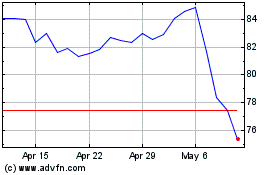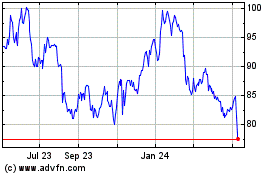Sony Unveils Big System to Archive Corporate Data
March 08 2016 - 9:50AM
Dow Jones News
Many companies have little idea where their data will be in 100
years. Sony Corp. is betting it will be stored on optical
discs.
The Japanese company on Tuesday unveiled a massive, jukebox-like
system called Everspan that is designed to store, fetch and read
high-capacity discs that are descendants of CDs and DVDs. Sony said
it would offer a 100-year guarantee on the disc media.
Sony is one of many companies trying to develop long-term
storage technology. Panasonic Corp., for example, in January
introduced an archival system based on optical discs that are
expected to be compatible with Sony's.
The two longtime rivals and others are trying to address needs
of companies that expect to retain data for a very long time. They
face worries current storage options—primarily tape drives—will at
some point stop reliably retaining data, or that hardware to read
aging storage formats will become unavailable.
Yet another fear is that companies will have to keep spending to
transfer old information as new storage media become available.
With Everspan, "they will never have to migrate or remaster the
data," said Frank Frankovsky, who is spearheading the effort as
chief executive of Sony Optical Inc.
Mr. Frankovsky is better known in Silicon Valley for having led
Facebook Inc.'s hardware design and supply-chain operations as well
as the Open Compute Project, a multicompany effort that promotes
open-source designs for Web-style computer servers and network
switches. He joined Sony in 2015 after Sony bought a startup he
formed, Optical Archive Inc.
Many companies today use tape-cartridge systems for long-term
data storage, an approach that backers say has advantages such as
the large capacity of each cartridge. But discs have their own
selling points, including the ability to retrieve a particular
piece of data without needing to rewind or fast-forward.
Where conventional CD-Rs and DVD-Rs record data on organic
materials that can degrade over decades, the new archival discs are
based on inorganic materials that are expected to retain data
longer. They also have higher capacity than the highest-capacity
conventional discs, Blu-ray, which typically store about 50
gigabytes of data. Sony's initial models store 300 gigabytes, while
Panasonic is starting with 100 gigabyte discs.
Millenniata Inc., a Utah-based startup, has been offering discs
that work with Blu-ray devices based on an inorganic material that
it says can store data for 1,000 years. It offers capacities up to
100 gigabytes.
Sony's ulterior motive is to sell hardware, which includes a
robotic system that shuttles behind refrigerator-size cabinets to
retrieve trays full of discs. Everspan uses up to 64 drives to read
data at extremely high speed, Mr. Frankovsky said.
While tape-drive storage systems generally house drives and
cartridges in separate facilities, Everspan places discs and
readers alongside companies' server systems, shortening the time to
retrieve archived data. Power consumption is extremely low, Mr.
Frankovsky said. An air filtration system to reduce dust buildup
draws most of the power.
Potential customers evaluating the system, which is expected to
be generally available in July, include Los Alamos National
Laboratory, Mr. Frankovsky said. The company isn't disclosing
pricing, since such system sales are typically negotiated
individually, he said.
Mr. Frankovsky's former employer, Facebook, in January said it
helped Panasonic develop its storage system and expected to deploy
it. He attributed that choice largely to Sony's decision to delay
shipping its system to add key features, hinting that Facebook may
eventually use hardware for both companies.
"The fact that customers immediately have a choice between two
optical storage suppliers is great for the industry," he said.
Write to Don Clark at don.clark@wsj.com
(END) Dow Jones Newswires
March 08, 2016 09:35 ET (14:35 GMT)
Copyright (c) 2016 Dow Jones & Company, Inc.
Sony (NYSE:SONY)
Historical Stock Chart
From Mar 2024 to Apr 2024

Sony (NYSE:SONY)
Historical Stock Chart
From Apr 2023 to Apr 2024
